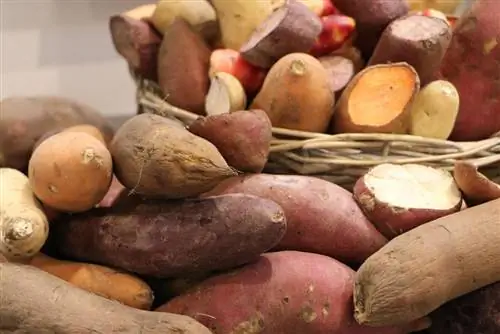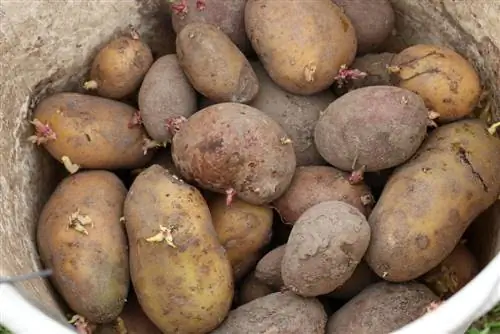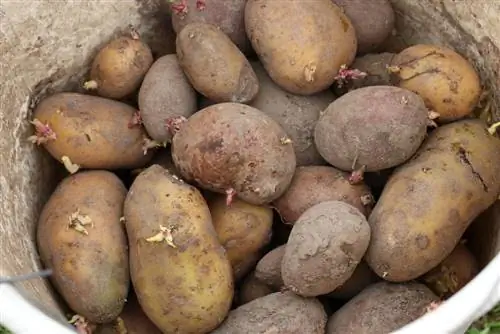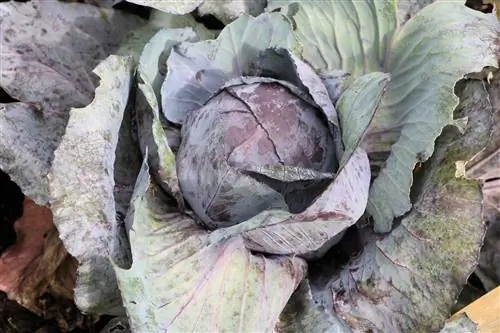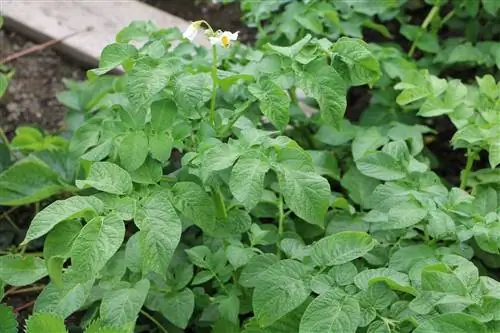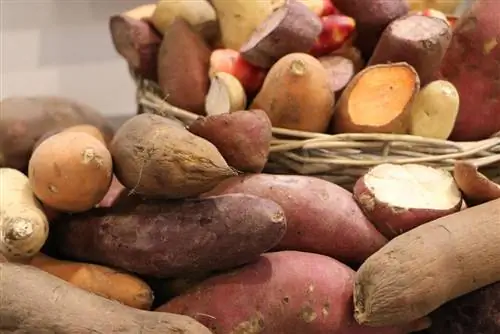- Author admin [email protected].
- Public 2023-12-17 03:39.
- Last modified 2025-01-24 12:45.
Wherever they appear, red potatoes magically attract everyone's attention. A feast for the eyes in the bed and a treat for the palate on the plate are attributes that characterize varieties with red skin and yellow flesh as well as species with a red color through and through. Given the wide variety of types, hobby gardeners are unsure which red potato is suitable for their own green kingdom. The following overview presents the best varieties and provides useful information about growing them in private gardens.
Varieties with red skin and light flesh
Laura
Among the red potatoes, Laura is the undisputed leader in the ranking of the most popular varieties. Thanks to its dark red skin, it stays crisp and fresh for longer in the right storage location, as long as it is cool, dry and dark there. Ideal for delicate casseroles and hearty stews.
- Mid-early
- Predominantly waxy
Asterix
If you are looking for a particularly high-yielding red potato variety, you will find it here. In addition to its first-class taste, Asterix proves to be resistant to tuber blight and potato nematodes.
- Mid-late
- Washy
Cheyenne
A new, red-skinned variety is coming onto the German market from France. The breeders promise good yields and the best storage properties. The yellow flesh conveys the typical potato taste with an intense aroma.
- Mid-early
- Washy
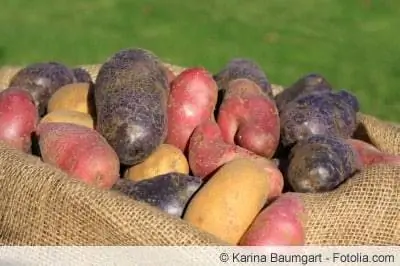
Cherie
While other red potatoes are peeled, Cherie can be eaten with the tender skin on. With its elongated oval silhouette, this variety cuts a fine figure on any plate. In cultivation it is uncomplicated and easy to care for.
- Very early maturity
- Predominantly waxy
Red King Edward VII
You can get a powerful tuber with a dark red skin color out of the ground when harvesting with this variety. Ideally suited as a delicious baked potato so that you can also visually enjoy the colorful potato after preparation. In cultivation, nutrient supply and irrigation are particularly relevant.
- Late maturity
- Predominantly waxy
Sputnik
The variety name served as a homage to the first satellite in space in 1960. The delicious potato from Poland has a light red skin and white, melt-in-the-mouth flesh.
- Early ripening
- Predominantly waxy
Rhine Red
An old variety from the Rhineland with impressive tubers that are ideal for preparing classic potato salads as well as crispy fried potatoes. The cream-colored flesh offers a nice contrast to the red skin.
- Mid-late
- Predominantly waxy
Linzer Rose
A popular breed in Austria thanks to its delicate pink skin and creamy yellow flesh. The taste keeps what the appearance promises. After the harvest, the Linzer Rose impresses with its unusually long dormancy, meaning it can be stored wonderfully in the cellar.
- Medium early ripening
- Predominantly waxy
Mayan Twilight
Fancy a spotted potato? Then choose Mayan Twilight from Peru for growing in the garden. With their red shell and funny yellow spots on their eyes, planting, caring for and preparing them is even more fun. It also has an unusual taste, which is a little reminiscent of marzipan.
- Early variety
- Predominantly waxy
Peach Bloom
Red-yellow marbled skin and buttery good taste, these are the outstanding attributes of this old variety from 1850. Hobby gardeners will enjoy Peach Bloom with its undemanding nature as long as it is not exposed to frosty temperatures. Whether as boiled potatoes, baked potatoes or prepared for dumplings, this variety is convincing across the board.
- Medium early ripening
- Floury cooking
Varieties with red peel and red flesh
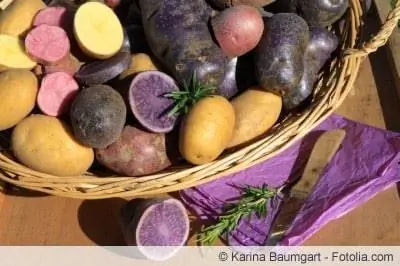
Highland Burgundy Red
A red-fleshed delicacy with a delicate melt. Native to the Scottish Highlands since 1902, this variety is considered a real collector's item among hobby gardeners. The wine-red skin is wonderfully smooth, so that each of the tubers is a pleasure to use when processing.
- Mid-late
- Flourycooking
Royal Purple
The German competitor to the red-fleshed Scottish variety scores with a unique, slightly nutty aroma and a long tradition since 1860. The oval shape with a smooth, bright red peel attracts everyone's attention.
- Mid-early
- Predominantly waxy
Magenta Love
The rare gem with red skin and intense red-colored flesh only recently went on sale. Fine in aroma and nutty in taste, the variety brings color to potato salad, to the frying pan and surprises as crunchy, red chips.
- Mid-late
- boiling
Red Salad Potato
Long oval shape with red skin and red flesh, this variety from the heart of Germany is conquering the hobby gardens of Europe. The fact that the tubers remain comparatively small at 20-50 mm does not detract from the visual effect or the aroma.
- Late ripening
- Washy
Information about cultivation
Their dramatic outfit does not mean that red potatoes differ from the classics in cultivation. Once you have discovered your new favorite variety, it is less capricious to grow than you might expect. These aspects are important:
Site and soil preparation
To grow red potatoes, choose a bed that has not hosted potatoes or other nightshades in the previous 3 years. Ideally, the location is sunny, warm and protected. The seeds will happily take root in loamy-sandy soil, rich in humus and with a slightly acidic pH value of 5.5-6. You can create the best conditions for growing red potato varieties with the following soil preparation:
- Dig the bed 2 spades deep in the fall of the previous year
- Optimize the soil with compost, leaf mold, sand and horn meal
- Let the soil rest until spring
Pre-germinating seed potatoes
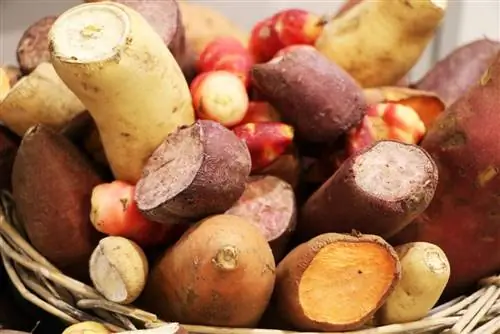
Red early potatoes can be pre-germinated behind glass so that the noble rarities start the outdoor season with a robust growth lead. In this way, you can also strengthen your resistance to the dreaded late blight. In mid to late March, fill an old wooden box with a potting soil and sand mixture and place the red seed potatoes in it. The side with the most eyes faces up. In a bright window seat at 12-15 degrees Celsius, water the seeds every now and then so that strong shoots develop with an optimal length of 4-5 centimeters.
Plants
Once the soil has warmed up to 8-10 degrees Celsius, the time has come to plant seed potatoes. If the weather is normal, this is the case for early varieties in early/mid-April. Plant medium-early red potatoes in mid/late April so that the late varieties follow them by the end of May. How to handle it correctly:
- Rake the bed, pull out all the weeds and create a fine topsoil
- Incorporate sifted compost and rock dust as organic starting fertilizer
- Make dead straight furrows 15 centimeters deep, with row spacing of 60 centimeters
- Place the seed potatoes at a distance of 30-40 centimeters and cover them with a maximum of 5 centimeters of soil
- The tips of pre-germinated shoots must still be visible from the substrate
Just consolidate the soil with your hands and then water the seeds with a fine spray. Early and mid-early varieties are covered with fleece to protect against delayed ground frosts.
Tip:
A mobile polytunnel protects the cultivation of red potatoes particularly effectively against the frosty hustle and bustle of the Ice Saints until mid-May and the cold of sheep in June.
Care tips
In order for the cultivation of red potatoes to result in a lush harvest of rich, premium-quality tubers, the following care is required in the bed:
- Pile the young plants at least 8 centimeters high from a height of 15 centimeters
- As you progress, repeatedly pile up loose substrate until a protective wall is formed
- Weed and water regularly in dry conditions
- Fertilize organically with compost, cattle dung, horn shavings and rock dust until flowering
Mulching the bed soil with leaves or straw will prevent infestation by late blight. In this way, no splash water reaches the potato leaves when watering, which closes one of the most dangerous ways for fungal spores to spread.
Conclusion
Red potatoes bring variety to the bed and to the menu. Regardless of their exotic appearance, the differences in planting, care and taste compared to classic potatoes are minimal. The overview of the best varieties listed here would like to help you choose your new favorite variety in the red dress. The information about cultivation shows how easy it is to cultivate the red-skinned and red-fleshed potatoes. Reason enough to start the experiment in your own garden.

